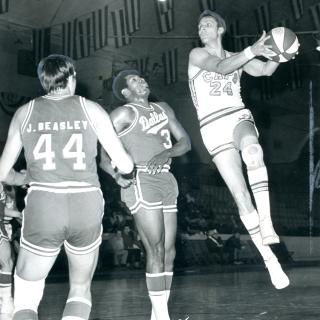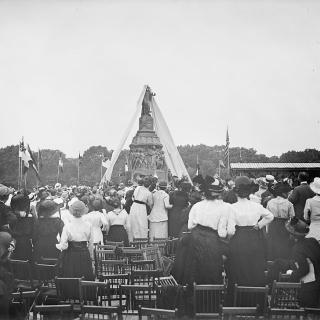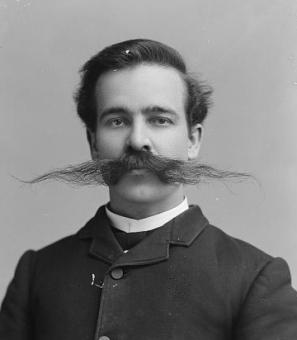George Mason's Impressive Ride to the Final Four
There are some teams you expect to see excel each year in college basketball. Schools like the University of North Carolina or UCLA, which holds the record for most NCAA championship wins at 11.
As of 2006, George Mason University was hardly a known quantity on the college basketball scene. The Fairfax school had only advanced to the NCAA tournament three times, and it had never won a single tournament game. Mason, largely a commuter school at the time, had only been playing in Division I since 1978.
This explains, then, why one player’s dream of making it all the way to the Final Four seemed a bit out there back in 2005.
The team’s coach Jim Larranaga brought a friend of his, sports psychologist Bob Rotella, up to Fairfax to meet with his team in October ’05. “We went into a small classroom in our physical education building. He [Rotella] asked the guys to close their eyes, put their head on the desk and dream the biggest dream of what they thought the season could be like,” Larranaga told the Washington Post 10 years later, “After a few minutes, he asked them to raise their heads and to volunteer their dream. Lamar Butler raised his hand and said, ‘I dreamt we went to the Final Four.’”[1]
Larranaga himself seemed to sense that this particular team was special. “I thought we were going to have the best season in George Mason history. I thought this was the best team I had coached,” he said as part of this Post feature marking the 10th anniversary of the 2006 season.[2]
That year, Mason finished the regular season with a strong record—22-6 overall and 15-3 in its Colonial Athletic Association (CAA). The team tied with the University of North Carolina-Wilmington to earn its first CAA regular season title since 2000. Despite the strong finish, however, the team faltered in the CAA tournament, losing to Hofstra in the semifinals and missing out on an automatic bid to the NCAA tournament.
Now it was a waiting game to see if the George Mason Patriots would earn a slot. Larranaga hoped the team’s record, an impressive winning streak and a high-profile victory over Wichita State would be enough to push them over the edge.[3] However, players also worried the selection committee would penalize them for an incident during their last game. Tony Skinn, a guard, was suspended for punching a Hofstra player in the groin.[4]
The Patriots ultimately earned an 11th seed. But getting into the tournament was one thing, winning was another. In the first round, Mason was set to take on Michigan State, a familiar face in the Sweet 16 and the Final Four.
The Patriot’s 75-65 win was the beginning of a wild postseason ride.[5]
Washington Post sports columnist Michael Wilbon wrote:
“The team without an NCAA victory in its history, a team that put the ‘mid’ in mid-major -- a team playing without its best player -- beat a power conference powerhouse here Friday night. And even if it wasn't the biggest upset of the day -- Northwestern State beating Iowa qualifies as that -- it was big enough for George Mason which, after 27 years of basketball, discovered the true joy of March Madness.”[6]
The thrill of George Mason’s success came from sheer shock value of an underdog school taking on teams full of future NBA players. But, even more, the sweetness of each victory came from how the big-name teams overlooked Mason’s skill.
In the next round, the Patriot’s task was to knock off the University of North Carolina, defending champions who were not expecting Mason to present much of a threat. A former UNC player told the Post on the 10-year anniversary, “To be honest with you, once we heard George Mason, we overlooked them. We thought we were going on to the next round.”[7]
The game, played in Dayton, Ohio, got off to a rocky start, with the Patriots trailing 16-2 in the first four minutes. Jai Lewis recalls he was nervous the team’s critics—who felt Mason didn’t deserve to be there—would be proven right.
“I was like, ‘Oh, no. We’re about to get blown out on national TV. Everybody’s predictions are about to come true, saying we shouldn’t have even been in the tournament,’” he said.[8]
Larranga pulled the team together to offer some guidance. He recounted on the 10-year anniversary:
I said, “Look, everybody listen to me. ... Listen to what I have to say.’ And I paused. I said, ‘We got these guys right where we want ’em.’ The players looked at me like, ‘We do?’ I said, ‘Yeah, look down at their bench … See? They’re celebrating. They think this game is already over. And we haven’t even begun to play.’”[9]
Mason went on to win 65-60.[10] The Patriots were going to the Sweet 16.
The team’s triumph brought immediate celebrity to the George Mason players and a new energy to the campus. That night, players and coaches made the trek back from Ohio and received a police escort to campus, where they found a “hastily scheduled” pep rally already in full swing. The crowd roared with excitement.[11]
The next morning, players were mobbed with hugs and handshakes, requests for pictures and autographs. Students wore yellow “We Believe” T-shirts, and the bookstore placed a rush order for “Sweet 16” shirts.[12]
Maybe the best quote from all the media coverage comes from a member of the student fan club, the “Patriot Platoon,” who told Butler: “You’re awesome dude, totally … Your picture is all over, everywhere. I saw you on ESPN this morning. This basketball team has awesomely, single-handedly changed everything about this university.”[13]
The deluge of media attention was new, too. A massive press corps wanted access to the players and their coach. Reporters followed them around. Butler was on the cover of Sports Illustrated, with the cover image headlined, “Lamar Butler Leads George Mason into the Sixteen as Upsets Rattle the Brackets.”
Everyone wondered, though, would the Patriots’ unprecedented run continue? Few thought they’d make it this far.
For the next game, George Mason got the chance to play in their own backyard, only 20 miles from the school’s Fairfax campus at the Verizon Center. On March 24, they beat Wichita State 63-55.[14] Two days later, they took on the University of Connecticut.
An 11th seed team that had its first three NCAA wins all in the past two weeks was going up against a No. 1 seed.
Regular play ended in a tie, and the game went into overtime. With seconds to go, Mason held a slight, two-point lead, but Connecticut had the ball. Could Mason hold up under this sort of pressure? The arc of the Huskies’ final shot moved in slow motion.[15] It bounced off the rim, and the score stayed locked at 86-84. Mason was Final Four bound.
Post columnist Thomas Boswell called the defeat of U-Conn. the “greatest underdog feat in the history of Washington sports.” Out of “athletic obscurity,” Boswell wrote, came a team worth noticing. He bet that many Washington-area fans could name 100 players on the local pro teams and the major college ones, but could not name a single person who has “ever played for George Mason.”[16]
“Count me, too,” he wrote, “Now we all go six deep, right?”[17]
Butler later recalled that, freshman year, he was passing out flyers when a school employee commented, “We have a basketball team?”[18] No one could say that now. Reflecting on the ’06 season as part of a WETA documentary, Butler described what it was like to tackle such major teams in the NCAA tournament.
“You want to get recruited by these schools. And when they say you’re too small, or you’re too this, you kind of carry that chip on your shoulder,” he said, “So when you play against them it’s like I’m going to prove you wrong.”[19]
All the anticipation was building up to April 1 when the Mason team arrived in Indianapolis to take on the University of Florida. In the end, the team lost to Florida by 15, and the wild ride ended.
After the game, Larranga approached Butler and said, “You know, I’m mad at you.” The coach reminded his player about that October meeting with the sports psychologist, when Butler said he dreamt the team would advance to the Final Four.[20]
“You should have dreamed we won the national championship” Larranga said.[21]
All jokes aside, George Mason’s loss capped a truly revolutionary season. The team was disappointed to lose—who wouldn’t be? But the Cinderella story of the Mason Patriot’s lives on in sports lore, and students on Mason’s campus are still very conscious of this history.
After the season, the director of Mason’s Sports Management Institute determined the school received more than $677,000 of free publicity during the tournament.[22] The school also witnessed a 50 percent increase in fundraising for its intercollegiate athletics program as well as a general increase in contributions from alumni. Applications numbers shot up, particularly from out-of-state applicants. In 2006, approximately 16 percent of students were from outside Virginia.[23] Today that number is around 20.[24]
A wild run for the history books had put Mason on the map. The basketball team might return to the Final Four again, but as then-president Alan Merten put it, “It may happen again, but it’ll never happen again for the first time.”[25]
Footnotes
- ^ Kilgore, Adam, Dan Steinberg, Jorge Ribas, Eddie Alvarez, “Inside the Most Unlikely Run in NCAA Tournament History,” The Washington Post, March 4, 2016. https://www.washingtonpost.com/sf/sports/wp/2016/03/04/mason-madness-in…
- ^ Ibid.
- ^ “A History of George Mason University: 1996–2012: Prominence: The Season of a Lifetime: George Mason University's Improbable and Amazing Journey to the Final Four.” ahistoryofmason.gmu.edu/exhibits/show/presence/contents/the-season-of-a-lifetime--geor
- ^ Ibid.
- ^ AllBrackets.com. 2006 NCAA Men's Basketball Tournament Bracket, www.allbrackets.com/bracket.php?year=2006.
- ^ Wilbon, Michael, “Mid-Major Patriots’ Victory is Major,” The Washington Post, March 18, 2006. http://www.washingtonpost.com/wp-dyn/content/article/2006/03/17/AR20060…
- ^ “Inside the Most Unlikely Run in NCAA Tournament History,” The Washington Post.
- ^ Ibid.
- ^ Ibid.
- ^ AllBrackets.com. 2006 NCAA Men's Basketball Tournament Bracket, www.allbrackets.com/bracket.php?year=2006.
- ^ Steinberg, Dan, “Overnight Success, Instant Changes at George Mason,” The Washington Post, March 21, 2006. http://www.washingtonpost.com/wp-dyn/content/article/2006/03/20/AR20060…
- ^ Ibid.
- ^ Ibid.
- ^ AllBrackets.com. 2006 NCAA Men's Basketball Tournament Bracket, www.allbrackets.com/bracket.php?year=2006.
- ^ Washington in the 2000s. Written and produced by Seth Tillman. WETA, 2019.
- ^ Boswell, Thomas, “One for the History Books,” The Washington Post, March 28, 2006. http://www.washingtonpost.com/wp-dyn/content/article/2006/03/27/AR20060…
- ^ Ibid.
- ^ Washington in the 2000s. Written and produced by Seth Tillman. WETA, 2019.
- ^ Ibid.
- ^ “Inside the Most Unlikely Run in NCAA Tournament History,” The Washington Post.
- ^ Ibid.
- ^ “A History of George Mason University: 1996–2012."
- ^ George Mason University Factbook 2006-2007, p. 32 https://irr2.gmu.edu/factbooks/0607/Factbook0607_Final.pdf
- ^ George Mason Key Facts for 2018, https://relations.gmu.edu/wp-content/uploads/2018/05/2018-State-Govt-Ke…
- ^ Joshi, Monika, “Transformative Leadership: An Oral History of the Merten Presidency (1996-2012),” Student Media George Mason University, May 18, 2012. https://issuu.com/osmgmu/docs/etched_in_stonemerten_web





![Sketch of the mythical fuan by Pearson Scott Foresman. [Source: Wikipedia]](/sites/default/files/styles/crop_320x320/public/2023-10/Goatman_Wikipedia_Faun_2_%28PSF%29.png?h=64a074ff&itok=C9Qh-PE1)












